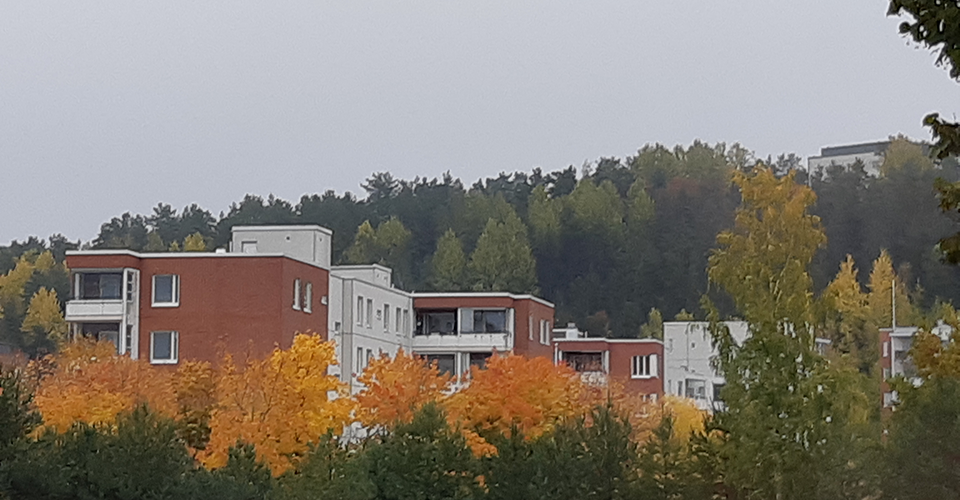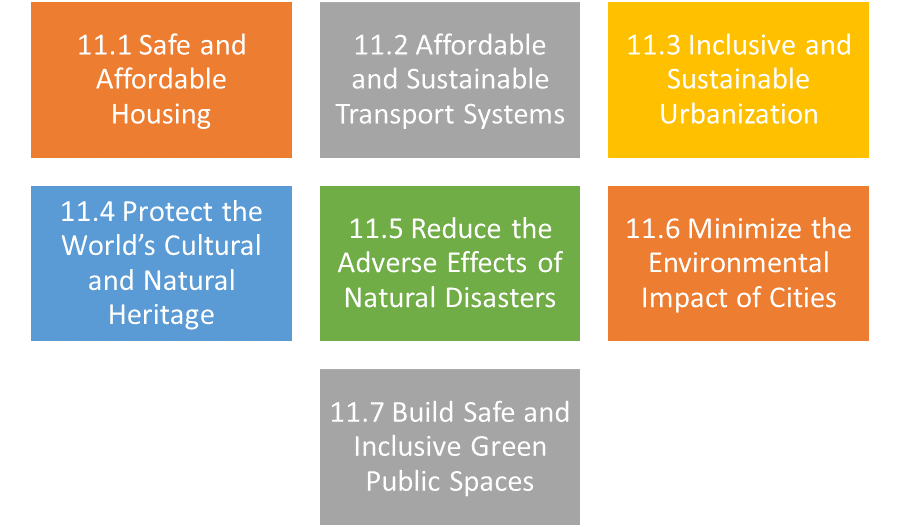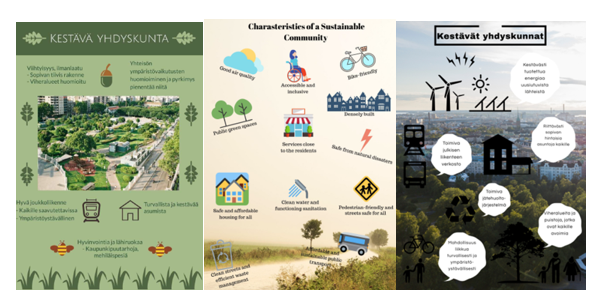
Eeva Aarrevaara & Pentti Viluksela
Sustainability of cities and communities has just recently become a major issue, considering the impact of the globally spreading COVID-19 pandemic. This was not anticipated when preparing a learning package considering sustainable communities was started last year. Health issues are not even very clearly articulated in the particular sustainability development goal considering communities. However, the material aiming to deconstruct main features of sustainable communities opens challenging viewpoints, especially when comparing solutions of different international cities. This material was produced to benefit all universities of applied sciences in circular economy education.
Mission impossible – sustainable community?
Sustainable community was chosen as one sub theme in the project Circular Economy for Universities of Applied Sciences. Principal lecturer Pentti Viluksela produced the introductory material for the topic in Spring 2019, and his colleague Eeva Aarrevaara was utilizing, developing further and piloting the material in her lectures in Autumn 2019. The starting point of this field was goal number 11 in the UN Sustainability Goals, Sustainable Cities and Communities (United Nations 2020). The authors argue that although working under the large umbrella of circular economy, one might consider, that urban planning is the area where the crucial decisions are carried out to create positive circumstances to support and enable circular economy actions. In other words, without suitable urban planning, it will be far more challenging to achieve the goals circular economy actions need.
The general goal of SDG 11 is to make cities and human settlements inclusive, safe, resilient and sustainable by 2030, which is divided into sub goals as presented in figure 1.

The previous Finnish government founded the committee for sustainable development in 2016 and launched the website Commitment 2050 (Sitoumus 2050), where several private and public organisations have published their commitments dealing with sustainability goals. In April 2020, over 2200 commitments were published. There are eight objectives, one of them being Sustainable society and local communities. Several of the objectives are connected with circular economy. (Sitoumus 2050, 2020)
How to combine livability and sustainability in Finland
The students participating in the pilot course were asked to produce a poster of the issue “Sustainable community”, which proved to be a successful task, a couple of examples of the student posters are included in this article (figure 2).

As an adaptation of SDG 11 goals, separate examples of urban development were evaluated in Finland, especially in Helsinki region – what kinds of new development are taking place, what is their connection with the public transportation network and how do they identify other sustainability goals in practice. Helsinki provides multiple examples to study critically how sustainability aspects are expressed and realized (Helsingin kaupunki 2019).
Ministry of Economic Affairs and Employment of Finland, together with other central governmental bodies, has made so called growth agreements with the largest cities. New agreements are under preparation and possibly covering also city regions with over 100 000 inhabitants. The agreement procedure for land use, housing and transport (MAL) aims to support the development of cities, and especially their residential policy and production. According to Vatilo (2018) the following viewpoints are important in the new agreement period: Enough land should be reserved for residential construction. Traffic infrastructure should support especially sustainable transport and moving, and the emissions of land use, living and traffic should decline by 50% by 2030.
Although the economical growth has concentrated in cities, also the smaller towns and rural localities, as well as villages, are important factors in the national and regional networks, and provide local citizens functional environments. The report of The Ministry of Economic Affairs and Employment of Finland has introduced two alternative scenarios for the future development until 2030. The first one is ”Finland as a network of regions in which different urban and rural regions are livable” and the second: ”Livability is concentrated on the big urban regions ”. (Ponto, Kuhmonen & Osenius 2018, 18–20).
Learning from forerunner cities – how sustainability change is managed
Students in Lahti University of Applied Sciences were collecting information in groups from so called forerunner cities, meaning cities, which at least have created an image to be advanced in sustainability issues. Cities of Amsterdam, Berlin, Vancouver, Oslo and Copenhagen were explored concerning sustainability factors, like green areas, new developments, mobility and energy use.
Except Berlin, these cities are quite similar by size, only Amsterdam is slightly bigger compared to Oslo, Copenhagen and Vancouver, which all have more than 600 000 inhabitants. Berlin has the population of 3,7 million inhabitants. All cities are presenting agendas to increase the greenery inside the urban area with different kinds of actions. The area of green space will be raised into 15% in the inner city of Oslo, and in urban regions, into 20% of the area. Vancouver has a goal to increase the canopy cover to 22% by 2050, which will increase the cooling effect of trees in urban areas. Berlin has launched the goal to have 30% of urban areas for green infrastructure.
New urban developments of the cities demonstrate transition processes from an old use to a new one. Several waterfront areas are developed as Fjord City in Oslo which changes the waterfront areas in the city from industrial use into a residential, commercial and recreational area (Nordregio 2020). Another example of a new sustainable residential district is Buckow in Berlin, containing energy-efficient buildings, a large landscape park, limited car traffic, a close network of pedestrian and cycle paths, parking spaces for car sharing, and charging spaces for electric cars.
Most of the cities have the goal to become carbon neutral in 2050, except Copenhagen, which is aiming to be the first carbon-neutral capital by 2025. Amsterdam will permit only emission-free vehicles in the city centre in 2030. Berlin limits currently the access to inner city only for low-emission cars. The share of public transportation is already relatively high in all the cities, and in Oslo the number of trips using public transport has increased by 63 percent during the past ten years. The share of private cars is in most cities around 30% of all the trips. Amsterdam, Oslo and Copenhagen have also set the same goal to move into carbon-free public transportation in 2020s.
By 2030, 55% of the energy used in Vancouver is derived from renewable sources, and the goal is to increase the use to 100% by 2050. In Oslo most of the energy is derived from hydropower, and only small shares of wind and thermal power are used in energy production. Copenhagen is mostly based on wind energy (55%) and the share of biomass is 18%, coal 17% and gas 6%. Berlin faces the biggest challenges in the use of renewable energy, because in 2015 only 4% was based on renewable sources and the goal for 2033 is 65% of energy production from renewable sources.
Comparing international examples in Metropolia
A similar assignment was given to the students of Metropolia University of Applied Sciences, in the course Towards sustainable society. Student groups had free hands to select interesting or important sustainability issues. The chosen cities were Vancouver, Amsterdam, Singapore, Melbourne and the commune of Ii in Finland.
The findings were very similar to the ones presented above. Vancouver and Copenhagen have quite similar sustainability priorities and activities, while Singapore and Melbourne, much bigger cities, and located in different geographies, show other concerns, e.g. water supply and green buildings. Many student groups highlighted city actions to improve urban air quality and waste management, including circular economy and waste to energy solutions. Additional sustainability topics brought up by the student groups included climate change mitigation, political decision-making, housing, culture, education and healthcare.
Municipality of Ii, with a population of 10 000, stands in stark contrast with the big cities. Ii has won acclaim for its climate action, waste management, and community participation. Ii shares the notion observed in all forerunners: they have far more ambitious sustainable strategies, and faster and more effective actions than those of national or federal governments.
Unpredictable challenges of urbanisation
The Finnish context of living has lately strongly concentrated in urbanization, but in the light of the recent global pandemic, as a phenomenon the attitude towards urbanization might change, at least for a while, from mostly positive to more skeptical (see also Rosling, Rosling & Rönnlund 2019). The vulnerability of the densely built areas seems obvious, not only to natural disasters and climate change but also to health issues. Obviously the scale of urbanization in Finland is very different from the Central European context, and especially from the most growing mega cities and regions in Asian countries, which are anticipated to dominate the future urbanization. Although attention was paid to bigger cities in this context, it is obvious that also villages and rural localities have strengths as sustainable communities, and there is a need to look closer at them in the future.
As the COVID-19 pandemic impacts densely populated urban areas most, there might be a need to redefine the sub-goals of SDG 11. Health-related hazards might be added to sub-goal 11.5, which now concentrates on natural disasters. The role of cities in achieving SDG3 (Ensure healthy lives and promote well-being for all at all ages; especially sub-goals 3.3 and 3B, C and D) should also be strengthened.
Authors
Eeva Aarrevaara, LAB University of Applied Sciences, Principal lecturer, DSc (Arch.), eeva.aarrevaara(at)lab.fi
Pentti Viluksela, Metropolia University of Applied Sciences, Principal lecturer, DSc (Tech.), pentti.viluksela(at)metropolia.fi
References
Helsingin kaupunki. (2019). Uutta Helsinkiä. Available at: https://www.uuttahelsinkia.fi/fi. [accessed 15 September 2019].
Ministry of Economic Affairs and Employment of Finland. (2020). Growth agreements.. Available at: https://tem.fi/en/growth-agreements . [accessed 29th March 2020]
Ministry of the Environment. (2020). Agreements on land use, housing and transport. Available at: https://www.ym.fi/en-US/Land_use_and_building/Steering_of_land_use_planning/Landuse_housing_and_transport_letters_of_intent [accessed 29th March 2020].
Nordregio. (2020). Fjord City: A waterfront urban renewal project. Available at: https://nordregio.org/sustainable_cities/fjordbyen/ [accessed 1 April 2020].
Ponto, H., Kuhmonen, H.-M. & Osenius, J. (Eds.). (2018). Keskustelunavauksia alueiden Suomeen. Ministry of Economic Affairs and Employment of Finland. Raportti 23/2018. http://urn.fi/URN:ISBN:978-952-327-315-3
Rosling, H., Rosling, O. & Rosling Rönnlund, A. (2019). Faktojen maailma. Keuruu: Kustannusosakeyhtiö Otava.
Sitoumus 2050. (2020). Available at https://www.sitoumus2050.fi/en_US/web/sitoumus2050/home#/ [accessed 4 April 2020].
United Nations. (2020). Sustainable Development Goal 11 – Make cities and human settlements inclusive, safe, resilient and sustainable. Available at: https://sustainabledevelopment.un.org/sdg11 [accessed 4 April 2020].
Vatilo, M. (2018). Presentation in RASTI seminar.



